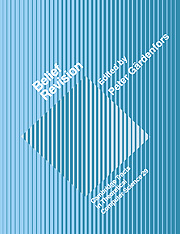Book contents
- Frontmatter
- Contents
- Belief revision: An introduction
- Reason maintenance and belief revision: Foundations versus coherence theories
- Syntax based approaches to belief revision
- A dyadic representation of belief
- On the logic of theory change: More maps between different kinds of contraction functions
- Belief change and possibility theory
- On the difference between updating a knowledge base and revising it
- Planning from first principles
- Autonomous belief revision and communication
- Conditionals and knowledge-base update
- Index
Reason maintenance and belief revision: Foundations versus coherence theories
Published online by Cambridge University Press: 21 September 2009
- Frontmatter
- Contents
- Belief revision: An introduction
- Reason maintenance and belief revision: Foundations versus coherence theories
- Syntax based approaches to belief revision
- A dyadic representation of belief
- On the logic of theory change: More maps between different kinds of contraction functions
- Belief change and possibility theory
- On the difference between updating a knowledge base and revising it
- Planning from first principles
- Autonomous belief revision and communication
- Conditionals and knowledge-base update
- Index
Summary
INTRODUCTION
Recent years have seen considerable work on two approaches to belief revision: the so-called foundations and coherence approaches. The foundations approach supposes that a rational agent derives its beliefs from justifications or reasons for these beliefs: in particular, that the agent holds some belief if and only if it possesses a satisfactory reason for that belief. According to the foundations approach, beliefs change as the agent adopts or abandons reasons. The coherence approach, in contrast, maintains that pedigrees do not matter for rational beliefs, but that the agent instead holds some belief just as long as it logically coheres with the agent's other beliefs. More specifically, the coherence approach supposes that revisions conform to minimal change principles and conserve as many beliefs as possible as specific beliefs are added or removed. The artificial intelligence notion of reason maintenance system (Doyle, 1979) (also called “truth maintenance system”) has been viewed as exemplifying the foundations approach, as it explicitly computes sets of beliefs from sets of recorded reasons. The so-called AGM theory of Alchourrón, Gärdenfors and Makinson (1985; 1988) exemplifies the coherence approach with its formal postulates characterizing conservative belief revision.
Although philosophical work on the coherence approach influenced at least some of the work on the foundations approach (e.g., (Doyle, 1979) draws inspiration from (Quine, 1953; Quine and Ullian, 1978)), Harman (1986) and Gärdenfors (1990) view the two approaches as antithetical. Gärdenfors has presented perhaps the most direct argument for preferring the coherence approach to the foundations approach.
- Type
- Chapter
- Information
- Belief Revision , pp. 29 - 51Publisher: Cambridge University PressPrint publication year: 1992
- 39
- Cited by



